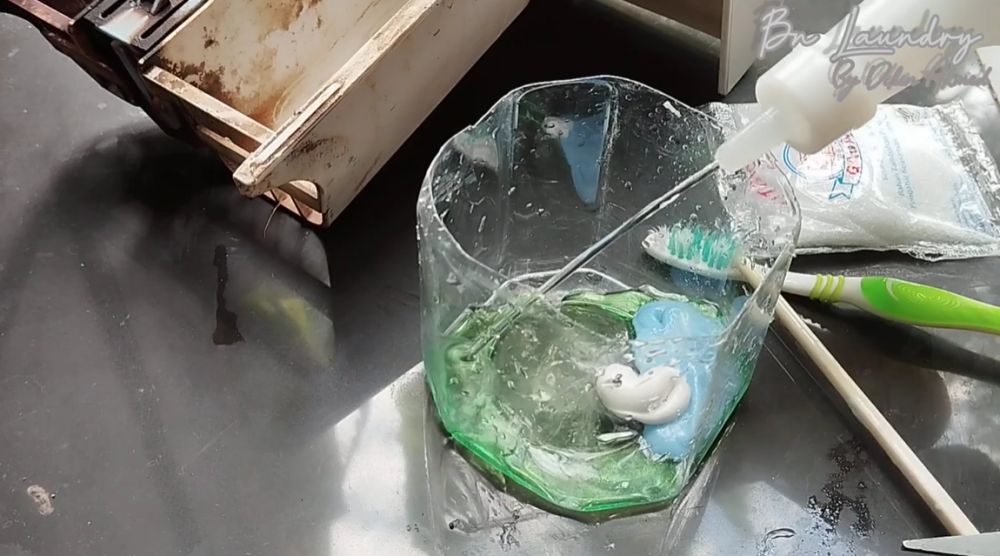foto: YouTube/BNofficial
Brilio.net - A dipper is one of the bathing devices that is important to pay attention to cleanliness. Not only a scoop, a bucket is also a water container that should always be clean. If both tools are dirty and mossy, the water could be contaminated.
Ideally, scoops and buckets should be cleaned regularly every week. Otherwise, moss will grow on the dippers and buckets. Moreover, if these two tools are made of plastic, moss will usually spread easily and make the ladle or bucket slippery.
It cannot be denied that high exposure to water makes plastic ladles and buckets dirty and mossy. Not infrequently, mold also grows on each side of this tool. If left alone, the moss can thicken or even become crusty, you know.
If it becomes crusty, the moss stain will be even more difficult to clean. Just rubbing it with soap and a brush is not enough. Therefore, you need to use a special liquid so that this moss crust can be removed optimally.
Luckily, a YouTube user BNofficial once shared an easy trick to remove moss crust from plastic scoops and buckets. Through one of the uploaded videos, he admitted that he used simple ingredients. Some of them even come from the kitchen, you know.
How to clean moss crust on scoops and buckets.
Reported by BrilioFood on Monday (11/3), the cleaning materials used were dab soap, citron and toothpaste. Meanwhile, for additional kitchen ingredients, he relies on dishwashing soap and cooking vinegar. A number of these ingredients can be effective in removing thick and crusty moss stains, you know.
How to use a number of these ingredients is quite easy. First of all, prepare a container for cleaning. Then pour in enough dishwashing soap and dab soap. If so, add a little toothpaste, add a few drops of citrus, and 1/2 sachet of citrus.

photo: YouTube/BNofficial
Next, just pour a little hot water. Only then stir until smooth. If so, immediately apply this liquid to the surface of the ladle and bucket. So, when smearing it, make sure the ladle and bucket are dry. After spreading it evenly, let it sit for a few minutes.

photo: YouTube/BNofficial
If you let it sit, this moss crust will start to fade. At this stage, water the ladle and bucket with a little warm water. Then scrub using wire wool and a clothes brush. Continue rubbing until the moss crust disappears.

photo: YouTube/BNofficial
If the moss crust is very thick, you can add more citrus solution. Then continue rubbing until clean. Finally, rinse the ladle and bucket under running water.

photo: YouTube/BNofficial
In the video, YouTube user BNofficial shows the results of a ladle and bucket that have been rinsed. Compared to before, this ladle and bucket really look shiny, you know. It's so clean, the appearance of the ladle and bucket looks like new. This indicates that the trick of removing moss crust on plastic ladles and buckets is very effective.
Natural ingredients to make and reproduce dishwashing soap.
To make your own dishwashing soap, you can use natural ingredients that are generally available in the kitchen or easily found in household chemical stores. Here are some materials that can be used:
1. Castile soap.
Castile soap is a natural soap made from vegetable oils. You can use this soap as a base for making dishwashing soap.
2. Water.
Clean water is used as a solvent and to mix other ingredients.
3. Vegetable oil.
Vegetable oils such as olive oil, coconut oil, or almond oil can be used to provide softness to dishwashing soap.
4. Essential oils.
Essential oils such as lemon oil, orange oil, or tea tree oil can provide a fresh aroma and antibacterial properties to dishwashing soap.
5. Soda ash.
Soda ash or sodium carbonate is an ingredient that can increase the cleaning power of soap.
6. Animal fat.
Animal fats such as beef tallow can be used as additional ingredients to provide softness to soap.
7. Salt.
Salt is used to stabilize the soap and water mixture.
8. Vinegar.
White vinegar is an ingredient that can neutralize pH and help remove stains and grease on dishes.
9. Baking soda.
Baking soda can be used as a gentle but effective natural cleaner to clean stains on dishes.
(brl/tin)